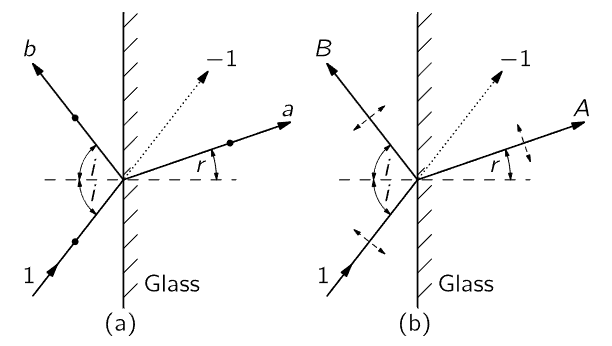
تاريخ الفيزياء

علماء الفيزياء


الفيزياء الكلاسيكية

الميكانيك

الديناميكا الحرارية


الكهربائية والمغناطيسية

الكهربائية

المغناطيسية

الكهرومغناطيسية


علم البصريات

تاريخ علم البصريات

الضوء

مواضيع عامة في علم البصريات

الصوت


الفيزياء الحديثة


النظرية النسبية

النظرية النسبية الخاصة

النظرية النسبية العامة

مواضيع عامة في النظرية النسبية

ميكانيكا الكم

الفيزياء الذرية

الفيزياء الجزيئية


الفيزياء النووية

مواضيع عامة في الفيزياء النووية

النشاط الاشعاعي


فيزياء الحالة الصلبة

الموصلات

أشباه الموصلات

العوازل

مواضيع عامة في الفيزياء الصلبة

فيزياء الجوامد


الليزر

أنواع الليزر

بعض تطبيقات الليزر

مواضيع عامة في الليزر


علم الفلك

تاريخ وعلماء علم الفلك

الثقوب السوداء


المجموعة الشمسية

الشمس

كوكب عطارد

كوكب الزهرة

كوكب الأرض

كوكب المريخ

كوكب المشتري

كوكب زحل

كوكب أورانوس

كوكب نبتون

كوكب بلوتو

القمر

كواكب ومواضيع اخرى

مواضيع عامة في علم الفلك

النجوم

البلازما

الألكترونيات

خواص المادة


الطاقة البديلة

الطاقة الشمسية

مواضيع عامة في الطاقة البديلة

المد والجزر

فيزياء الجسيمات


الفيزياء والعلوم الأخرى

الفيزياء الكيميائية

الفيزياء الرياضية

الفيزياء الحيوية

الفيزياء العامة


مواضيع عامة في الفيزياء

تجارب فيزيائية

مصطلحات وتعاريف فيزيائية

وحدات القياس الفيزيائية

طرائف الفيزياء

مواضيع اخرى
The intensity of reflected light
المؤلف:
Richard Feynman, Robert Leighton and Matthew Sands
المصدر:
The Feynman Lectures on Physics
الجزء والصفحة:
Volume I, Chapter 33
2024-03-24
1555
Let us now consider quantitatively the reflection coefficient as a function of angle. Figure 33–6(a) shows a beam of light striking a glass surface, where it is partly reflected and partly refracted into the glass. Let us suppose that the incident beam, of unit amplitude, is linearly polarized normal to the plane of the paper. We will call the amplitude of the reflected wave b, and the amplitude of the refracted wave a. The refracted and reflected waves will, of course, be linearly polarized, and the electric field vectors of the incident, reflected, and refracted waves are all parallel to each other. Figure 33–6(b) shows the same situation, but now we suppose that the incident wave, of unit amplitude, is polarized in the plane of the paper. Now let us call the amplitude of the reflected and refracted wave B and A, respectively.

Fig. 33–6. An incident wave of unit amplitude is reflected and refracted at a glass surface. In (a) the incident wave is linearly polarized normal to the plane of the paper. In (b) the incident wave is linearly polarized in the direction shown by the dashed arrows.
We wish to calculate how strong the reflection is in the two situations illustrated in Fig. 33–6(a) and 33–6(b). We already know that when the angle between the reflected beam and refracted beam is a right angle, there will be no reflected wave in Fig. 33–6(b), but let us see if we cannot get a quantitative answer—an exact formula for B and b as a function of the angle of incidence, i.
The principle that we must understand is as follows. The currents that are generated in the glass produce two waves. First, they produce the reflected wave. Moreover, we know that if there were no currents generated in the glass, the incident wave would continue straight into the glass. Remember that all the sources in the world make the net field. The source of the incident light beam produces a field of unit amplitude, which would move into the glass along the dotted line in the figure. This field is not observed, and therefore the currents generated in the glass must produce a field of amplitude −1, which moves along the dotted line. Using this fact, we will calculate the amplitude of the refracted waves, a and A.
In Fig. 33–6(a) we see that the field of amplitude b is radiated by the motion of charges inside the glass which are responding to a field a inside the glass, and that therefore b is proportional to a. We might suppose that since our two figures are exactly the same, except for the direction of polarization, the ratio B/A would be the same as the ratio b/a. This is not quite true, however, because in Fig. 33–6(b) the polarization directions are not all parallel to each other, as they are in Fig. 33–6(a). It is only the component of the electric field in the glass which is perpendicular to B, A cos (i+r), which is effective in producing B. The correct expression for the proportionality is then

Now we use a trick. We know that in both (a) and (b) of Fig. 33–6 the electric field in the glass must produce oscillations of the charges, which generate a field of amplitude −1, polarized parallel to the incident beam, and moving in the direction of the dotted line. But we see from part (b) of the figure that only the component of the electric field in the glass that is normal to the dashed line has the right polarization to produce this field, whereas in Fig. 33–6(a) the full amplitude a is effective, since the polarization of wave a is parallel to the polarization of the wave of amplitude −1. Therefore, we can write

since the two amplitudes on the left side of Eq. (33.2) each produce the wave of amplitude −1.
Dividing Eq. (33.1) by Eq. (33.2), we obtain

a result which we can check against what we already know. If we set (i+r)=90∘, Eq. (33.3) gives B=0, as Brewster says it should be, so our results so far are at least not obviously wrong.
We have assumed unit amplitudes for the incident waves, so that |B|2/12 is the reflection coefficient for waves polarized in the plane of incidence, and |b|2/12 is the reflection coefficient for waves polarized normal to the plane of incidence. The ratio of these two reflection coefficients is determined by Eq. (33.3).
Now we perform a miracle, and compute not just the ratio, but each coefficient |B|2 and |b|2 individually! We know from the conservation of energy that the energy in the refracted wave must be equal to the incident energy minus the energy in the reflected wave, 1−|B|2 in one case, 1−|b|2 in the other. Furthermore, the energy which passes into the glass in Fig. 33–6(b) is to the energy which passes into the glass in Fig. 33–6(a) as the ratio of the squares of the refracted amplitudes, |A|2/|a|2. One might ask whether we really know how to compute the energy inside the glass, because, after all, there are energies of motion of the atoms in addition to the energy in the electric field. But it is obvious that all of the various contributions to the total energy will be proportional to the square of the amplitude of the electric field. Therefore, we can write

We now substitute Eq. (33.2) to eliminate A/a from the expression above, and express B in terms of b by means of Eq. (33.3):

This equation contains only one unknown amplitude, b. Solving for |b|2, we obtain

So we have found the reflection coefficient |b|2 for an incident wave polarized perpendicular to the plane of incidence, and also the reflection coefficient |B|2 for an incident wave polarized in the plane of incidence!
It is possible to go on with arguments of this nature and deduce that b is real. To prove this, one must consider a case where light is coming from both sides of the glass surface at the same time, a situation not easy to arrange experimentally, but fun to analyze theoretically. If we analyze this general case, we can prove that b must be real, and therefore, in fact, that b = ±sin (i−r)/sin (i+r). It is even possible to determine the sign by considering the case of a very, very thin layer in which there is reflection from the front and from the back surfaces, and calculating how much light is reflected. We know how much light should be reflected by a thin layer, because we know how much current is generated, and we have even worked out the fields produced by such currents.
One can show by these arguments that

These expressions for the reflection coefficients as a function of the angles of incidence and refraction are called Fresnel’s reflection formulas.
If we consider the limit as the angles i and r go to zero, we find, for the case of normal incidence, that B2≈b2≈(i−r)2/(i+r)2 for both polarizations, since the sines are practically equal to the angles, as are also the tangents. But we know that sin i/sin r=n, and when the angles are small, i/r≈n. It is thus easy to show that the coefficient of reflection for normal incidence is

It is interesting to find out how much light is reflected at normal incidence from the surface of water, for example. For water, n is 4/3, so that the reflection coefficient is (1/7)2≈2%. At normal incidence, only two percent of the light is reflected from the surface of water.















 قسم الشؤون الفكرية يصدر مجموعة قصصية بعنوان (قلوب بلا مأوى)
قسم الشؤون الفكرية يصدر مجموعة قصصية بعنوان (قلوب بلا مأوى) قسم الشؤون الفكرية يصدر مجموعة قصصية بعنوان (قلوب بلا مأوى)
قسم الشؤون الفكرية يصدر مجموعة قصصية بعنوان (قلوب بلا مأوى) قسم الشؤون الفكرية يصدر كتاب (سر الرضا) ضمن سلسلة (نمط الحياة)
قسم الشؤون الفكرية يصدر كتاب (سر الرضا) ضمن سلسلة (نمط الحياة)

















